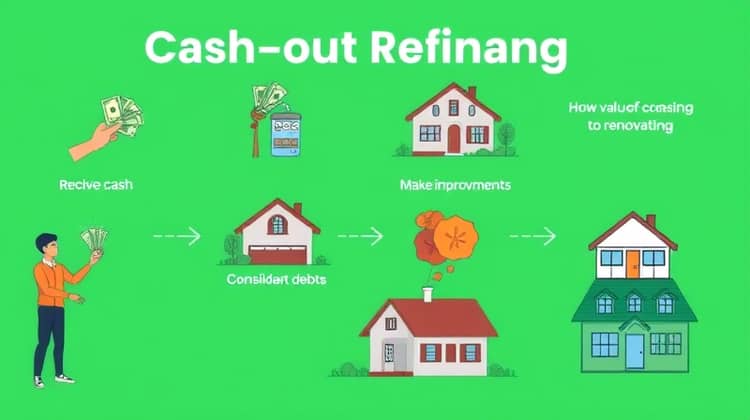Home improvement projects can greatly enhance the comfort, value, and aesthetic of your home. However, funding these improvements can be a significant concern for many homeowners. Fortunately, there are various financing options available that cater to different financial situations and project scopes.
In this article, we will explore seven popular financing options for home improvements. Whether you need a small amount of cash for a minor project or substantial funding for a major renovation, you'll find something that suits your needs.
1. Personal Loans

Personal loans are unsecured loans that can provide you with the flexibility to finance your home improvement projects. Because they are not secured by collateral, they often come with higher interest rates compared to secured loans, but they can be easier to obtain if you have a good credit score.
One of the main advantages of personal loans is that they can be used for any purpose, including home improvements. You can borrow a lump sum upfront and pay it back over time, usually through fixed monthly payments. This can be especially beneficial for those who are looking to manage their budget effectively.
- Quick and easy application process
- No collateral required
- Fixed monthly payments over a set term
- Can use the funds for any type of home improvement
Overall, personal loans can be a quick and effective way to finance smaller or mid-sized home improvement projects, especially if you have a good credit history. However, it's essential to review your financial situation to ensure that you can comfortably manage the monthly payments.
2. Home Equity Loans

Home equity loans allow homeowners to borrow against the equity in their homes. This type of loan is secured by your property, which means the lender has the right to seek repayment by assuming the property if you fail to meet the terms of the loan. Typically, home equity loans come with lower interest rates than personal loans due to this security.
These loans are often used for larger home improvement projects because they provide a lump sum of cash that can be repaid over a set term, usually at a fixed interest rate. Home equity loans might also have tax advantages, as the interest may be tax-deductible if used for home improvement purposes.
- Lower interest rates compared to personal loans
- Fixed payments make budgeting easier
- Can borrow a larger amount based on home equity
- Potential tax benefits on interest payments
However, you should be cautious when borrowing against your home. If you cannot make the payments, you could risk losing your home in foreclosure. It's crucial to consider your overall financial plan and ensure that borrowing against your home is a suitable option for you.
3. Home Equity Lines of Credit (HELOCs)

A Home Equity Line of Credit (HELOC) works similarly to a home equity loan but provides a revolving credit option. Homeowners can borrow money up to a certain limit using their home's equity as collateral. Unlike home equity loans, HELOCs usually come with adjustable interest rates and can be used repeatedly as long as you make the minimum payments. This flexibility makes them an attractive option for ongoing projects or when the costs of home improvements are uncertain.
HELOCs allow homeowners to draw money as needed, making them particularly useful for large or phased projects where you might not know the total costs upfront. You only pay interest on the amount borrowed, which can help balance cash flow, but the rate changes can lead to unpredictable payments.
- Flexible borrowing options
- Revolving credit allows for multiple draws
- Pay interest only on the amount used
- Ideal for ongoing projects with variable costs
While HELOCs offer flexibility, they come with the risk of fluctuating interest rates and the requirement to pay back the principal and the interest in the future. It's important to have a clear plan for repayment to avoid accumulating too much debt.
4. Cash-Out Refinancing

Cash-out refinancing involves taking out a new mortgage for more than you currently owe and receiving the difference in cash. This can be a beneficial option for those with low mortgage rates or significant home equity, as it allows you to finance home improvements and potentially get a lower interest rate on your overall mortgage.
- Get cash for home improvements
- Possible lower interest rate on the new mortgage
- Consolidate other higher-interest debts into a single loan
- Improve your home's value with renovations
However, this method increases your mortgage debt and may extend the life of your loan. It's essential to consider how this aligns with your financial goals before proceeding.
5. Credit Cards

Using credit cards for home improvements can be a quick solution, especially for small projects. Many credit cards come with rewards and cash-back benefits, making your renovation a little more rewarding financially.
- Easy access to funds for small or immediate projects
- Use rewards programs offered by many cards
- Potentially earn cash back on purchases
- Flexible payment options for small purchases
However, credit cards often come with high interest rates, so it’s essential to create a payment plan to avoid accruing unnecessary debt. Consider using them only for smaller projects or emergencies.
6. Government Loans and Grants

Various government programs help Americans make home improvements, especially for low- to moderate-income families. These loans and grants may come with favorable terms and can significantly reduce your financial burden during renovations. Options such as the FHA Title I home improvement loan and 203(k) loans can be very helpful.
Additionally, there are grants available for home improvements focused on energy efficiency, accessibility modifications, and other specific needs. Researching these options can lead to finding funds that do not require repayment, providing significant assistance to homeowners.
- FHA Title I Home Improvement Loan
- FHA 203(k) Loan
- Weatherization Assistance Program (WAP)
- Community Development Block Grant (CDBG) Program
Make sure to check the eligibility requirements and application processes to ensure you qualify for these beneficial programs. It’s a great opportunity for homeowners to receive aid in enhancing their living spaces.
7. Contractor Financing

Some contractors offer financing options directly through their services, including interest-free payment plans or loans tailored to the project's cost and your credit profile. This can be an excellent option as it simplifies the process by allowing you to manage financing and renovations through a single source.
Additionally, contractor financing might offer flexible payment terms specific to how the work is completed, so it’s essential to explore these options when starting a home improvement project.
Bottom Line

When considering financing home improvements, it’s essential to evaluate all your options to find the one that fits your financial situation and project requirements. From personal loans to government grants, the variety of options available can provide suitable solutions for most homeowners. Always ensure to review the terms and conditions of any financial product you consider, weighing the pros and cons to determine what aligns best with your goals.














